Boiling Water Method | Fruits | Tomatoes and Tomato Products | Vegetables | Meat, Game and Poultry
Fish and Seafood | Stock and Soup | Troubleshooting | Care and Maintenance | Pressure Canner Comparison Guide

BOILING WATER METHOD CANNING BASICS
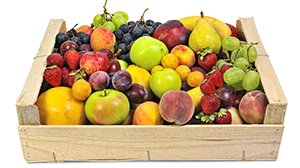 The Boiling Water Method of canning is used for high-acid foods such as jams, jellies, fruits, pickles, and salsa. Always follow the method listed on the research-tested recipe.
The Boiling Water Method of canning is used for high-acid foods such as jams, jellies, fruits, pickles, and salsa. Always follow the method listed on the research-tested recipe.
Current Presto® Pressure Canners function as both a pressure canner and a boiling water canner providing complete versatility and easy storage. See the chart below to determine if your Presto® Canner model is suitable for the Boiling Water Method. For the Boiling Water Method using the Presto Precise® Digital Pressure Canner, click here.
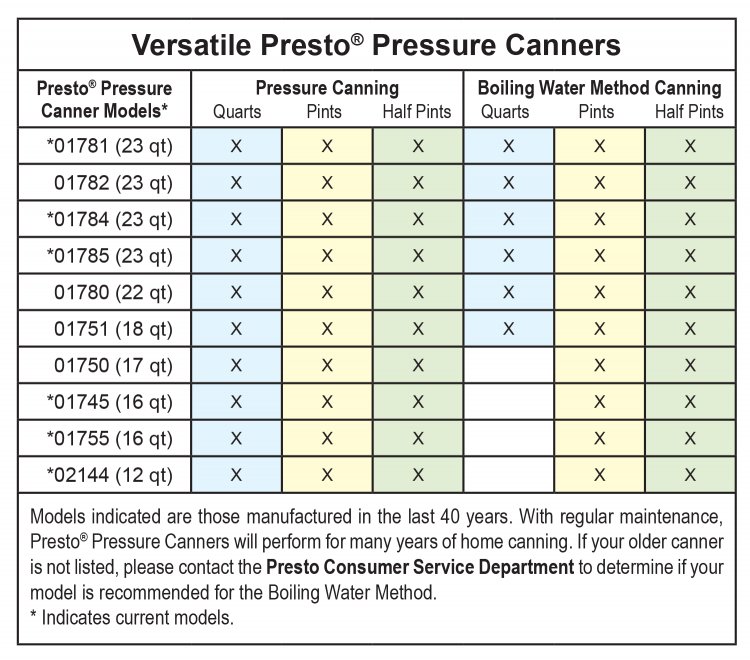
![]()
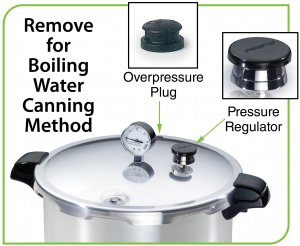 Place canning rack on bottom of canner. Fill canner halfway with water. Preheat water to 140°F for raw-packed foods or 180°F for hot-packed foods.
Place canning rack on bottom of canner. Fill canner halfway with water. Preheat water to 140°F for raw-packed foods or 180°F for hot-packed foods.
![]() To prevent canner from pressurizing, remove overpressure plug and pressure regulator from canner cover and set aside. These parts are not needed for the Boiling Water Method.
To prevent canner from pressurizing, remove overpressure plug and pressure regulator from canner cover and set aside. These parts are not needed for the Boiling Water Method.
![]() Be sure filled jars have lids and bands fastened according to manufacturer’s directions. Use a jar lifter to place jars straight down on canning rack in canner. Check water level. Add more boiling water so the water level is at least 1 inch above jar tops. Turn heat to its highest setting until water boils vigorously.
Be sure filled jars have lids and bands fastened according to manufacturer’s directions. Use a jar lifter to place jars straight down on canning rack in canner. Check water level. Add more boiling water so the water level is at least 1 inch above jar tops. Turn heat to its highest setting until water boils vigorously.
![]() Place cover on canner (with sealing ring in place), aligning the “V” mark on the cover with the corresponding mark on the body handle and lock securely by turning in the direction indicated to close the cover (clockwise). Cover handles must be centered over body handles. Do not force beyond this position.
Place cover on canner (with sealing ring in place), aligning the “V” mark on the cover with the corresponding mark on the body handle and lock securely by turning in the direction indicated to close the cover (clockwise). Cover handles must be centered over body handles. Do not force beyond this position.
![]() Set a timer for the minutes required for processing as listed in the recipe. Lower the heat setting to maintain a gentle boil throughout processing. Add more boiling water, if needed, to keep the water level above the jars.
Set a timer for the minutes required for processing as listed in the recipe. Lower the heat setting to maintain a gentle boil throughout processing. Add more boiling water, if needed, to keep the water level above the jars.
![]() When jars have been boiled for the recommended time, turn off the heat. Carefully remove the canner cover by lifting it toward you to keep steam away from you when opening. Let canner cool for 5 minutes before removing jars.
When jars have been boiled for the recommended time, turn off the heat. Carefully remove the canner cover by lifting it toward you to keep steam away from you when opening. Let canner cool for 5 minutes before removing jars.
![]() Using a jar lifter, remove jars by lifting straight up. Do not tilt jars because liquid may siphon out. Place jars upright on a towel or cooling rack. Be sure to leave at least a 1-inch space between jars during cooling. Allow jars to cool naturally 12 to 24 hours before checking for a seal. Do not retighten bands while cooling.
Using a jar lifter, remove jars by lifting straight up. Do not tilt jars because liquid may siphon out. Place jars upright on a towel or cooling rack. Be sure to leave at least a 1-inch space between jars during cooling. Allow jars to cool naturally 12 to 24 hours before checking for a seal. Do not retighten bands while cooling.
Adjusting Boiling Water Method for High Altitude Canning
When using the boiling water canning method at altitudes of 1,000 feet or below, process according to specific recipe. When canning at altitudes above 1,000 feet, increase processing time according to the Boiling Water Canning Chart shown below.
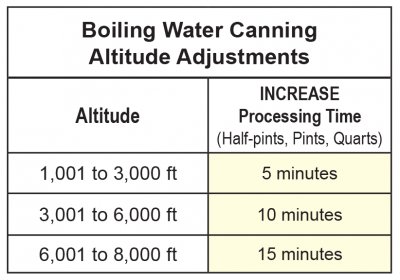
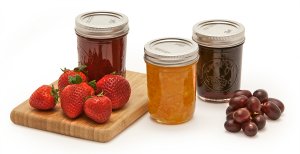 JAMS, JELLY, AND FRUIT BUTTER RECIPES
JAMS, JELLY, AND FRUIT BUTTER RECIPES
The following recipes are safely canned by the Boiling Water Method. Do not use the Pressure Canning Method on these recipes because the food quality will be unacceptable.
recommend reviewing the Canning Introduction link.
RHUBARB STRAWBERRY JAM half-pints | pints
- 1 cup cooked red-stalked rhubarb (about 1 pound rhubarb and 1/4 cup water)
- 2 1/2 cups crushed strawberries (about 1 1/2 quarts)
- 6 1/2 cups sugar
- 1 pouch liquid pectin
Yield: About 7 or 8 half-pints
Sterilize* Mason jars.
*If you wish, rather than sterilizing jars the processing time can be increased to 10 minutes. Keep in mind that if your altitude is above 1,000 feet the processing time needs adjustment.
Wash rhubarb and slice thin or chop; do not peel. Add water, cover, and simmer until rhubarb is tender, about 1 minute. Sort and wash fully ripe strawberries; remove stems and caps. Crush berries.
Measure prepared rhubarb and strawberries into a large pot. Add sugar and stir well. Place on high heat and, stirring constantly, bring quickly to a full rolling boil that cannot be stirred down. Boil hard for 1 minute, stirring constantly. Remove from heat and stir in pectin. Skim foam, if necessary.
Immediately ladle hot jam into hot jars, leaving 1/4-inch headspace. Clean jar rims. Position lids on jars and adjust bands fingertip tight.
 Boiling Water Canning
Boiling Water Canning
Follow step-by-step directions for your pressure canner’s boiling water method and canner-specific jar capacity.
- Dial Gauge, Weighted Gauge, and Presto Precise® Digital Canners. Process Half-pints and Pints 5 minutes or 10 minutes for unsterilized jars. For processing above 1,000 feet altitude, see chart for recommended time.
PEACH JAM half-pints | pints
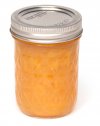 3 3/4 cups crushed peaches (about 3 pounds peaches)
3 3/4 cups crushed peaches (about 3 pounds peaches)- 1/4 cup lemon juice
- 1 package powdered pectin
- 5 cups sugar
Yield: About 6 half-pints
Sterilize* Mason jars.
*If you wish, rather than sterilizing jars the processing time can be increased to 10 minutes. Keep in mind that if your altitude is above 1,000 feet the processing time needs adjustment.
Sort and wash fully ripe peaches. Remove stems. Loosen skins by dipping peaches 30 to 60 seconds in boiling water, then in cold water. Peel and remove pits. Crush peaches.
In a large pot combine crushed peaches, lemon juice, and pectin; stir well. Cook on high heat and, stirring constantly, bring quickly to a full rolling boil that cannot be stirred down. Add sugar, continue stirring, and heat again to a full rolling boil. Boil hard for 1 minute, stirring constantly. Remove from heat. Skim foam, if necessary.
Immediately ladle hot jam into hot jars, leaving 1/4-inch headspace. Clean jar rims. Position lids on jars and adjust bands fingertip tight.
 Boiling Water Canning
Boiling Water Canning
Follow step-by-step directions for your pressure canner’s boiling water method and canner-specific jar capacity.
- Dial Gauge, Weighted Gauge, and Presto Precise® Digital Canners. Process Half-pints and Pints 5 minutes or 10 minutes for unsterilized jars. For processing above 1,000 feet altitude, see chart for recommended time.
GRAPE JELLY half-pints | pints
 5 cups grape juice (about 3 1/2 pounds grapes and about 1 cup water)
5 cups grape juice (about 3 1/2 pounds grapes and about 1 cup water)- 1 package powdered pectin
- 7 cups sugar
Yield: About 8 half-pints
Sterilize* Mason jars.
*If you wish, rather than sterilizing jars the processing time can be increased to 10 minutes. Keep in mind that if your altitude is above 1,000 feet the processing time needs adjustment.
Sort, wash, and remove stems from fully ripe grapes. In a large pot crush about 3 1/2 pounds of grapes and add just enough water to cover grapes, about 1 cup. Cover and bring to boil on high heat. Reduce heat and simmer for 10 minutes. Pour contents of pot into a damp jelly bag and suspend the bag to drain the juice into a large bowl. Allow juice to drain undisturbed overnight in a cool place. Strain through two thicknesses of damp cheesecloth to remove any crystals that have formed.
In a large pot combine juice and pectin; stir well. Place on high heat and, stirring constantly, bring quickly to a full rolling boil that cannot be stirred down. Add sugar, continue stirring, and heat again to a full rolling boil. Boil hard for 1 minute. Remove from heat; skim off foam quickly.
Immediately ladle hot jelly into hot jars, leaving 1/4-inch headspace. Clean jar rims. Position lids on jars and adjust bands fingertip tight.
 Boiling Water Canning
Boiling Water Canning
Follow step-by-step directions for your pressure canner’s boiling water method and canner-specific jar capacity.
- Dial Gauge, Weighted Gauge, and Presto Precise® Digital Canners. Process Half-pints and Pints 5 minutes or 10 minutes for unsterilized jars. For processing above 1,000 feet altitude, see chart for recommended time.
Rhubarb Strawberry Jam, Peach Jam, and Grape Jelly adapted from “How to make Jellies, Jams, and Preserves at Home.” Home and Garden Bulletin No. 56. Extension Service, United States Department of Agriculture. National Center for Home Food Preservation, June 2005.
APPLE BUTTER half-pints | pints
Use Jonathan, Winesap, Stayman, Golden Delicious, McIntosh, or other tasty apple varieties for good results.
- 8 pounds apples
- 2 cups apple cider
- 2 cups vinegar
- 2 1/4 cups white sugar
- 2 1/2 cups packed brown sugar
- 2 tablespoons ground cinnamon
- 1 tablespoon ground cloves
Yield: 8 to 9 pints
Sterilize* Mason jars.
*If you wish, rather than sterilizing jars the processing time can be increased to 10 minutes. Keep in mind that if your altitude is above 1,000 feet the processing time needs adjustment.
Wash apples. Remove stems, quarter and core fruit. Cook apples slowly in apple cider and vinegar until soft. Press fruit through a colander, food mill, or strainer. Cook fruit pulp with sugar and spices. stirring frequently. To test for doneness, remove a spoonful and hold it away from steam for 2 minutes. It is done if the butter remains mounded on the spoon. Another way to determine when the butter is cooked adequately is to spoon a small quantity onto a plate. When a rim of liquid does not separate around the edge of the butter, it is ready for canning.
Ladle hot butter into hot jars, leaving 1/4-inch headspace. Clean jar rims. Position lids on jars and adjust bands fingertip tight.
 Boiling Water Canning
Boiling Water Canning
Follow step-by-step directions for your pressure canner’s boiling water method and canner-specific jar capacity.
- Dial Gauge, Weighted Gauge, and Presto Precise® Digital Canners. Process Half-pints and Pints 5 minutes or 10 minutes for unsterilized jars. For processing above 1,000 feet altitude, see chart for recommended time.
Recipe adapted from the “Complete Guide to Home Canning,” Agriculture Information Bulletin No. 539, USDA, revised 2009. National Center for Home Food Preservation.
PICKLES AND PICKLED FOOD RECIPES
BREAD AND BUTTER PICKLES pints | quarts
- 6 pounds 4- to 5-inch pickling cucumbers
- 8 cups thinly sliced onions (about 3 pounds)
- 1/2 cup canning or pickling salt
- 1 cup pickling lime (optional, see below for making firmer pickles)
- 1/2 cup salt (optional, see below for making firmer pickles)
- 1 gallon water (optional, see below for making firmer pickles)
- 4 cups vinegar (5% acidity)
- 4 1/2 cups sugar
- 2 tablespoons mustard seed
- 1 1/2 tablespoons celery seed
- 1 tablespoon ground turmeric
Yield: About 8 pints
Wash cucumbers. Cut 1/16 inch off blossom end and discard. Cut into 3/16-inch slices.* Combine cucumbers and onions in a large bowl. Add canning salt. Cover with 2 inches crushed or cubed ice. Refrigerate 3 to 4 hours, adding more ice as needed. Drain cucumbers and onions.
For making pickles: In a large pot combine vinegar and remaining ingredients. Boil 10 minutes. Add cucumbers and onions and slowly reheat to boiling.
Fill hot jars with cucumbers, onions, and hot pickling liquid, leaving 1/2-inch headspace. Remove air bubbles. Clean jar rims. Position lids on jars and adjust bands fingertip tight.
*Optional, for firmer pickles: Mix pickling lime, salt, and water in a 2- to 3-gallon crock or enamelware container. (Caution: Avoid inhaling lime dust while mixing the lime-water solution.) Add cucumbers and soak in lime water for 12 to 24 hours, stirring occasionally. Remove from lime solution and rinse. Cover cucumbers with fresh cold water and soak in refrigerator 1 hour. Drain water from cucumbers. Repeat the rinsing and soaking steps two more times. Handle carefully, as slices will be brittle. Drain well. Continue with instructions above “For making pickles.”
 Boiling Water Canning
Boiling Water Canning
Follow step-by-step directions for your pressure canner’s boiling water method and canner-specific jar capacity.
- Dial Gauge, Weighted Gauge, and Presto Precise® Digital Canners. Process Pints and Quarts 10 minutes. For processing above 1,000 feet altitude, see chart for recommended time.
Storage: After processing and cooling, jars should be stored 4 to 5 weeks to develop ideal flavor.
QUICK FRESH-PACK DILL PICKLES pints | quarts
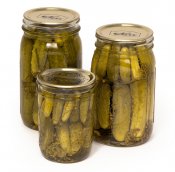 8 pounds 3- to 5-inch pickling cucumbers
8 pounds 3- to 5-inch pickling cucumbers- 2 gallons water
- 1 1/4 cups canning or pickling salt (divided)
- 1 1/2 quarts vinegar (5% acidity)
- 1/4 cup sugar
- 2 quarts water
- 2 tablespoons whole mixed pickling spice
- about 3 tablespoons whole mustard seed (1 teaspoon per pint jar)
- about 14 heads of fresh dill (1 1/2 heads per pint jar) or 4 1/2 tablespoons dill seed (1 1/2 teaspoons per pint jar)
Yield: About 7 to 9 pints
Wash cucumbers. Cut 1/16-inch slice off blossom end and discard, but leave 1/4-inch of stem attached. Dissolve 3/4 cup salt in 2 gallons water. Pour over cucumbers and let stand 12 hours. Drain. In a large pot combine vinegar, 1/2 cup salt, sugar, and 2 quarts water. Add mixed pickling spices tied in a clean, white cloth. Heat to boiling. Fill hot jars with cucumbers. Add 1 teaspoon mustard seed and 1 1/2 heads fresh dill per pint
Cover with boiling pickling liquid, leaving 1/2-inch headspace. Remove air bubbles. Clean jar rims. Position lids on jars and adjust bands fingertip tight.
 Boiling Water Canning
Boiling Water Canning
Follow step-by-step directions for your pressure canner’s boiling water method and canner-specific jar capacity.
- Dial Gauge, Weighted Gauge, and Presto Precise® Digital Canners. Process Pints 10 minutes and Quarts 15. For processing above 1,000 feet altitude, see chart for recommended time.
PICKLED JALAPEÑO PEPPER RINGS | pints
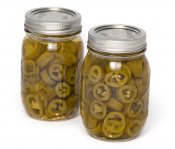 3 pounds jalapeño peppers
3 pounds jalapeño peppers- 1 1/2 cups pickling lime (optional, see below for making firmer pepper rings)
- 1 1/2 gallons water (optional, see below for making firmer pepper rings)
- 7 1/2 cups cider vinegar (5% acidity)
- 1 3/4 cups water
- 2 1/2 tablespoons canning salt
- 6 tablespoons mustard seed
- 3 tablespoons celery seed
Yield: About 6 pints
Caution: Wear plastic or rubber gloves and do not touch your face while handling or cutting hot peppers. If you do not wear gloves, wash hands thoroughly with soap and water before touching your face or eyes.
Wash peppers well and slice into 1/4-inch thick slices. Discard stem ends.*
To make pickled pepper rings: In a large pot combine cider vinegar, 1 3/4 cups water and canning salt; heat to boiling. Place 1 tablespoon mustard seed and 1 1/2 teaspoons celery seed in the bottom of each hot jar. Fill hot jars with pepper rings, leaving 1/2 inch headspace.
Cover pepper rings with boiling pickling liquid, leaving 1/2-inch headspace. Remove air bubbles. Clean jar rims. Position lids on jars and adjust bands fingertip tight.
*Optional, for firmer pepper rings: Mix pickling lime and 1 1/2 gallons water in a stainless steel, glass or food grade plastic container. (Caution: Avoid inhaling lime dust while mixing the lime-water solution.) Add peppers and soak in the lime water in refrigerator for 18 hours stirring occasionally (12 to 24 hours may be used). Remove pepper rings from lime solution. Rinse peppers gently but thoroughly with water. Cover pepper rings with fresh cold water and soak, in refrigerator, 1 hour. Drain water from peppers. Repeat the rinsing, soaking, and draining steps two more times, draining thoroughly at the end. Continue with instructions above “To make pickled pepper rings.”
 Boiling Water Canning
Boiling Water Canning
Follow step-by-step directions for your pressure canner’s boiling water method and canner-specific jar capacity.
- Dial Gauge, Weighted Gauge, and Presto Precise® Digital Canners. Process Pints 10 minutes. For processing above 1,000 feet altitude, see chart for recommended time.
PICKLED BANANA PEPPER RINGS | pints
- 2 1/2 to 3 pounds yellow (banana) peppers
- 4 tablespoons mustard seed
- 2 tablespoons celery seed
- 5 cups cider vinegar (5% acidity)
- 1 1/4 cups water
- 5 teaspoons canning salt
Yield: About 4 pints
Caution: Wear plastic or rubber gloves and do not touch your face while handling or cutting hot peppers. If you do not wear gloves, wash hands thoroughly with soap and water before touching your face or eyes.
Wash peppers well and remove stem ends; slice peppers in 1/4-inch thick rings. Place 1 tablespoon mustard seed and 1/2 tablespoon celery seed in the bottom of each empty hot jar. Fill hot jars with pepper rings, leaving 1/2-inch headspace.
In a large pot combine vinegar, water and salt; heat to boiling. Cover pepper rings with boiling pickling liquid, leaving 1/2 inch headspace. Remove air bubbles. Clean jar rims. Position lids on jars and adjust bands fingertip tight.
 Boiling Water Canning
Boiling Water Canning
Follow step-by-step directions for your pressure canner’s boiling water method and canner-specific jar capacity.
- Dial Gauge, Weighted Gauge, and Presto Precise® Digital Canners. Process Pints 10 minutes. For processing above 1,000 feet altitude, see chart for recommended time.
SALSA RECIPES
The following recipes are safely canned by the Boiling Water Method. Do not use the Pressure Canning Method on these recipes because the food quality will be unacceptable. To ensure the best and safest home canned product, we recommend reviewing the Canning Introduction link.
TOMATO SALSA | pints
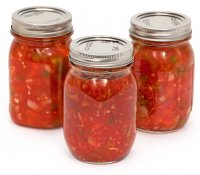 7 quarts peeled, cored, chopped paste or plum tomatoes*
7 quarts peeled, cored, chopped paste or plum tomatoes*- 5 cups chopped onion
- 4 cups seeded, chopped long green chiles
- 1/2 cup seeded, finely chopped jalapeño peppers
- 6 cloves garlic, finely chopped
- 2 cups bottled lemon or lime juice
- 2 tablespoons salt
- 1 tablespoon black pepper
- 3 tablespoons dried oregano leaves (optional)
- 2 tablespoons ground cumin (optional)
- 2 tablespoons fresh cilantro (optional)
*This recipe works best with paste tomatoes. Slicing tomatoes require a much longer initial cooking time to achieve a desirable consistency.
Yield: About 16 to 18 pints
Caution: Wear plastic or rubber gloves and do not touch your face while handling or cutting hot peppers. If you do not wear gloves, wash hands thoroughly with soap and water before touching your face or eyes.
The jalapeño peppers do not need to be peeled. The skin of the long green chiles may be tough. If you choose to peel chiles, wash and dry them and then slit each pepper along the side to allow steam to escape. Blister skins by placing peppers in a hot oven (400°F) or under a broiler for 6 to 8 minutes until skins blister. After blistering skins, place peppers in a pan and cover with a damp cloth. Cool several minutes; peel off skins. Discard seeds and chop.
Wash tomatoes and dip in boiling water for 30 to 60 seconds or until skins split. Dip in cold water, slip off skins, and remove cores.
Hot Pack: Combine all ingredients except oregano, cumin, and cilantro in a large pot and bring to a boil, stirring frequently, then reduce heat and simmer 10 minutes. Add oregano, cumin, and cilantro and simmer for another 20 minutes, stirring occasionally.
Ladle hot salsa into hot jars, leaving 1/2-inch headspace. Remove air bubbles. Clean jar rims. Position lids on jars and adjust bands fingertip tight.
 Boiling Water Canning
Boiling Water Canning
Follow step-by-step directions for your pressure canner’s boiling water method and canner-specific jar capacity.
- Dial Gauge, Weighted Gauge, and Presto Precise® Digital Canners. Process Pints 15 minutes. For processing above 1,000 feet altitude, see chart for recommended time.
TOMATILLO GREEN SALSA | pints
- 5 cups chopped tomatillos or green tomatoes
- 1 1/2 cups seeded, chopped long green chiles
- 1/2 cup seeded, finely chopped jalapeño peppers
- 4 cups chopped onions
- 1 cup bottled lemon or lime juice
- 6 cloves garlic, finely chopped
- 1 tablespoon ground cumin (optional)
- 3 tablespoons dried oregano leaves (optional)
- 1 tablespoon salt
- 1 teaspoon black pepper
Yield: About 5 pints
Caution: Wear plastic or rubber gloves and do not touch your face while handling or cutting hot peppers. If you do not wear gloves, wash hands thoroughly with soap and water before touching your face or eyes.
Remove the dry outer husks from tomatillos; wash thoroughly. They do not need to be peeled or seeded.
The jalapeño peppers do not need to be peeled but seeds are often removed. The skin of the long green chiles may be tough. If you choose to peel chiles, wash and dry them and then slit each pepper along the side to allow steam to escape. Blister skins by placing peppers in a hot oven (400°F) or under a broiler for 6 to 8 minutes until skins blister. After blistering skins, place peppers in a pan and cover with a damp cloth. Cool several minutes; peel off skins. Discard seeds and chop.
Hot Pack: Combine all ingredients in a large pot and stir frequently over high heat until mixture begins to boil, then reduce heat and simmer for 20 minutes, stirring occasionally.
Ladle hot salsa into hot jars, leaving 1/2-inch headspace. Remove air bubbles. Clean jar rims. Position lids on jars and adjust bands fingertip tight.
 Boiling Water Canning
Boiling Water Canning
Follow step-by-step directions for your pressure canner’s boiling water method and canner-specific jar capacity.
- Dial Gauge, Weighted Gauge, and Presto Precise® Digital Canners. Process Pints 15 minutes. For processing above 1,000 feet altitude, see chart for recommended time.
PEACH SALSA | half-pints
- 6 cups diced underripe, but yellow, peaches
- 1 1/2 cups diced red bell pepper
- 1/2 cup finely chopped yellow onion
- 1/2 teaspoon crushed red pepper flakes
- 2 teaspoons finely chopped garlic
- 2 teaspoons finely chopped ginger
- 1 cup light brown sugar
- 1 1/4 cups cider vinegar (5% acidity)
- 1/2 cup water
Yield: About 6 half-pints
Wash all produce well. Peel and chop peaches into 1/2-inch cubes. Dice bell pepper into 1/2-inch pieces. Finely chop yellow onions.
Hot Pack: Combine all ingredients in a large pot. Bring to a boil over high heat, stirring to dissolve sugar. Reduce heat and simmer 5 minutes.
Ladle hot solids into hot jars, leaving 1/2 inch headspace. Cover with hot liquid, leaving 1/2-inch headspace. Remove air bubbles. Clean jar rims. Position lids on jars and adjust bands fingertip tight.
 Boiling Water Canning
Boiling Water Canning
Follow step-by-step directions for your pressure canner’s boiling water method and canner-specific jar capacity.
- Dial Gauge, Weighted Gauge, and Presto Precise® Digital Canners. Process Half-pints 10 minutes. For processing above 1,000 feet altitude, see chart for recommended time.
SPICY CRANBERRY SALSA half-pints | pints
- 6 cups chopped red onion
- 4 finely chopped large Serrano peppers
- 1 1/2 cups water
- 1 1/2 cups cider vinegar (5% acidity)
- 1 tablespoon canning salt
- 1 1/3 cups sugar
- 6 tablespoons clover honey
- 12 cups (2 3/4 pounds) rinsed, fresh whole cranberries
Yield: About 6 pints
Caution: Wear plastic or rubber gloves and do not touch your face while handling or cutting hot peppers. If you do not wear gloves, wash hands thoroughly with soap and water before touching your face or eyes.
Hot Pack: Combine all ingredients except cranberries in a large pot and bring to a boil, stirring frequently, then reduce heat slightly and boil gently for 5 minutes. Add cranberries, reduce heat slightly and simmer mixture for 20 minutes, stirring occasionally to prevent scorching.
Leave pot over low heat while filling jars. Ladle hot salsa into hot jars, leaving 1/4-inch headspace. Remove air bubbles. Clean jar rims. Position lids on jars and adjust bands fingertip tight.
 Boiling Water Canning
Boiling Water Canning
Follow step-by-step directions for your pressure canner’s boiling water method and canner-specific jar capacity.
- Dial Gauge, Weighted Gauge, and Presto Precise® Digital Canners. Process Half-pints or Pints 10 minutes. For processing above 1,000 feet altitude, see chart for recommended time.

Boiling Water Method | Fruits | Tomatoes and Tomato Products | Vegetables | Meat, Game and Poultry
Fish and Seafood | Stock and Soup | Troubleshooting | Care and Maintenance | Pressure Canner Comparison Guide
